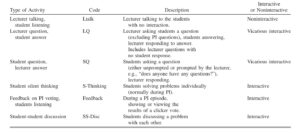Framework for Interactive Learning in Lectures (FILL)
A tool for characterising classroom practices
FILL+ is a highly repeatable and reliable tool for characterising classroom practices
The Framework for Interactive Learning in Lectures (FILL) was developed in 2014 by Anna Wood, together with colleagues in the Physics Education Research Group at the University of Edinburgh. The original work coded 16 lectures from a first year Physics Class at the University of Edinburgh “Framework for Interactive Learning in Lectures” (FILL) developed by Wood et al.
The framework provides a simple way to characterise the activities that take place in a lecture – in other words to ask ‘What are the students doing? and What is the lecturer doing?’.
In comparison to other characterisations tools FILL uses a continuous coding method which gives an accurate picture, to the nearest second of the interactions that take place in a lecture. It is straightforward to learn and has good inter-rater reliability.

FILL categories
The FILL framework also introduces the categories of ‘Interactive’, ‘Vicarious Interactive’ and ‘Non-interactive’ to describe each activity.
A short video introducing FILL framework
Research
Projects that have used FILL
“Characterizing interactive engagement activities in a flipped introductory physics class.” Wood, Anna K., et al. Physical Review Physics Education Research 12.1 (2016): 010140
“From students to scientists: The impact of interactive engagement in lectures.” McMillan, Craig, Daphne Loads, and Heather A. McQueen. “From students to scientists: The impact of interactive engagement in lectures.” New Directions in the Teaching of Physical Sciences 13 (2018).
What really happens in active engagement lectures? Craig Young, Judy Hardy, Anna Wood, PERC 2018n Conference
FILL+
In 2019 FILL+ was developed as an extension of the earlier FILL framework.
Principally it makes two small changes to FILL – expanding the LQ (Lecturer question) category into LQ (lecturer question) and SR (Student response) and the SQ (Student question ) category into SQ (Student question) and LR (lecturer response).
Research
Several projects have made use of FILL+ so far.
Developing FILL+
The initial work to develop FILL+ was a collaboration between researchers in the School of Mathematics, the School of Physics and Astronomy, and the Royal (Dick) School of Veterinary Studies.
This project was funded by the Principal’s Teaching Awards Scheme.
- “Reliable classification of classroom practices using lecture recordings”, BSRLM, Belfast, 9 November 2019
- “Reliable Classification of Classroom Practices using Lecture Recordings”, Online Seminar On Undergraduate Mathematics Education, 26 May 2020
- “Reliable classification of classroom practices using lecture recordings”, University of Edinburgh Learning and Teaching Conference 2020, Online, 25 June 2020
- “Reliable classification of classroom practices using lecture recordings”, TEMSE Seminar, University of Edinburgh, 29 October 2020
- Anderson, R., & Gant, T. (2019). Characterising teaching practices using lecture recordings. Teaching Matters blog.
- Kinnear, G., Smith, S., Anderson, R., Gant, T., MacKay, J. R. D., Docherty, P., Rhind, S., Galloway, R. (2021). “Developing the FILL+ tool to reliably classify classroom practices using lecture recordings”. Journal for STEM Education Research. https://doi.org/10.1007/s41979-020-00047-7
- Wood A K, Kinnear, G, Using classroom observation tools to characterize large classes in: Effective Teaching in Large STEM Classes 2023 https://iopscience.iop.org/book/edit/978-0-7503-5231-4/chapter/bk978-0-7503-5231-4ch4
Mathematics lecturers’ use of questions
Using FILL+ codes for 136 mathematics lectures, we identified a total of 2460 questions asked by lecturers. We then used a coding scheme from previous research to carry out further analysis.
- “Lecturers’ use of questions in undergraduate mathematics lectures”, BSRLM, Online, 14 November 2020
- Kinnear, G., Hood, G., Lardet, E., Sheard, C., Foster, C. (submitted). “Lecturers’ use of questions in undergraduate mathematics lectures”
Teacher reflections
We have an ongoing project, funded by the Principal’s Teaching Awards Scheme, to investigate how FILL+ can help to support teacher reflection.
We have carried out a series of semi-structured interviews to explore lecturers’ response to seeing the results of applying FILL+ to their classes.
- “Supporting teachers’ reflection using data about classroom activities”, University of Edinburgh Learning and Teaching Conference 2021, Online, 16 June 2021
- Wood, A. K., Christie, H., MacKay, J. R. D., & Kinnear, G. (2022). Using data about classroom practices to stimulate significant conversations and aid reflection. International Journal for Academic Development. https://doi.org/10.1080/1360144X.2022.2103817
- Wood, A. (2022). A data-led approach to reflection on teaching. Teaching Matters blog, The University of Edinburgh.
Training
If you would like to use FILL+, we have produced a training manual (supported by sample lecture clips) that you can use to learn how to apply the codes consistently.
Cite as: Smith, S., Anderson, R., Gant, T., & Kinnear, G. (2020). FILL+ Training Manual. https://doi.org/10.17605/OSF.IO/27863
Contact
If you have any questions about FILL+, please contact one of the team:
- Dr George Kinnear
- Anna Wood – email anna.wood at ed.ac.uk

